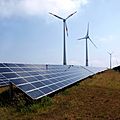Renewable energy commercialization facts for kids
Renewable energy commercialization involves many different technologies, including solar photovoltaics, solar thermal power plants, solar heating and cooling systems, wind power, hydroelectricity, geothermal power, biomass, and ocean energy systems. Each is at a different stage of development, yet the market is growing for many renewables.
Renewables contributed 19 percent to our energy consumption and 22 percent to our electricity generation in 2012 and 2013, respectively. Both, modern renewables, such as hydro, wind, solar and biofuels, as well as traditional biomass, contributed in about equal parts to the global energy supply. Worldwide investments in renewable technologies amounted to more than US$ 214 billion in 2013, with countries like China and the United States heavily investing in wind, hydro, solar and biofuels.
Renewable energy resources exist over wide geographical areas, in contrast to other energy sources, which are concentrated in a limited number of countries. Rapid deployment of renewable energy and energy efficiency is resulting in significant energy security, climate change mitigation, and economic benefits. In international public opinion surveys there is strong support for promoting renewable sources such as solar power and wind power. At the national level, at least 30 nations around the world already have renewable energy contributing more than 20 percent of energy supply. National renewable energy markets are projected to continue to grow strongly in the coming decade and beyond.
While many renewable energy projects are large-scale, renewable technologies are also suited to rural and remote areas, where energy is often crucial in human development. Globally, an estimated 3 million households get power from small solar PV systems. Micro-hydro systems configured into village-scale or county-scale mini-grids serve many areas. More than 30 million rural households get lighting and cooking from biogas made in household-scale digesters. Biomass cookstoves are used by 160 million households.
Rationale for renewables
Climate change, pollution, and energy insecurity are significant problems and addressing them requires major changes to energy supply and use. Renewable energy technologies are essential contributors to the energy supply portfolio, as they contribute to world energy security, reduce dependency on fossil fuels, and help to reduce greenhouse gases. Climate-disrupting fossil fuels are being replaced by clean, climate-stabilizing, non-depletable sources of energy: In global public opinion surveys there is strong support for promoting renewable sources such as solar power and wind power, requiring utilities to use more renewable energy, and providing tax incentives to encourage the development and use of such technologies.
EU member countries have ambitious renewable energy goals. In 2010, Eurobarometer polled the twenty-seven EU member states about the target "to increase the share of renewable energy in the EU by 20 percent by 2020". Most people in all twenty-seven countries either approved of the target or called for it to go further.
As of 2011, new evidence has shown that there are large risks associated with traditional energy sources, and that major changes to the mix of energy technologies is needed. Several mining tragedies globally have underscored the human toll of the coal supply chain. New EPA initiatives targeting air toxics, coal ash, and effluent releases highlight the environmental impacts of coal and the cost of addressing them with control technologies. Events at the Fukushima nuclear plant have renewed doubts about the ability to operate many nuclear plants safely over the long term. Cost estimates for “next generation” nuclear units continue to climb, and lenders are unwilling to finance these plants without taxpayer guarantees.
Other pages
- List of renewable energy topics
- Renewable energy commercialisation in Australia
- Renewable energy commercialization in the United States
Images for kids
-
The 22,500 MW Three Gorges Dam in the People's Republic of China, the largest hydroelectric power station in the world.
-
One of many power plants at The Geysers, a geothermal power field in northern California, with a total output of over 750 MW
-
Nellis Solar Power Plant at Nellis Air Force Base. These panels track the sun in one axis.
-
President Barack Obama speaks at the DeSoto Next Generation Solar Energy Center.
-
Solar Towers from left: PS10, PS20.
-
Neat ethanol on the left (A), gasoline on the right (G) at a filling station in Brazil.
-
Photovoltaic array and wind turbines at the Schneebergerhof wind farm in the German state of Rheinland-Pfalz
See also
 In Spanish: Comercialización de energías renovables para niños
In Spanish: Comercialización de energías renovables para niños


















